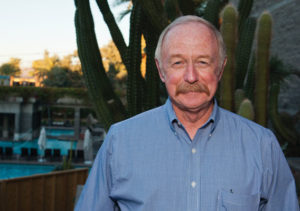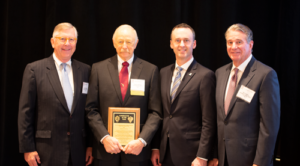Trent Latshaw named 2018 IADC Contractor of the Year
Trent Latshaw, President of Latshaw Drilling Co, was named as 2018 IADC Contractor of the Year on 9 November at the 2018 IADC Annual General Meeting held in New Orleans. The award was established in 1988 to recognize individual drilling contractors and their outstanding lifetime achievements in technical innovation, safety and economic efficiency within the drilling industry. Sponsored by National Oilwell Varco (NOV), the award is the only one in the industry reserved solely for drilling contractors. All recipients are nominated and selected by IADC drilling contractor members.

Mr Latshaw graduated from Texas A&M University in 1975 with a bachelor’s degree in petroleum engineering before going to work for Parker Drilling in Alaska as roughneck, motorman, derrickman and relief driller, both on land and offshore. He then worked for ARCO Alaska (Atlantic Richfield) as drilling engineer in its offshore district covering the Gulf of Alaska and Cook Inlet.
In 1982, at the age of 27, Mr Latshaw founded Latshaw Drilling Company and built two new 20,000- to 25,000-ft diesel-electric/SCR land rigs.
During the downturn of the mid-‘80s to the early 2000s, he shifted gears and began acquiring repossessed drilling rigs and equipment from financial institutions and at auctions. Between 1986 to 1992, he bought 10 complete drilling rigs and other major components that had a new replacement cost of over $100 million for just $5 million.
In 1996 to 1997, he acquired oilfield equipment manufacturers Mathey-Leland (wireline units) and Cooper Manufacturing (well-servicing rigs), both now part of NOV.

He began operating rigs again in 2003, starting with a 1,000-hp mechanical rig. Then in 2005, he started building new diesel-electric/SCR rigs. By 2012, he had built the company up to 17 rigs. The acquisition of Keen Energy Services in October of that year more than doubled the size of the company.
Over a nine-year period from 2003 to 2012, the company grew from one rig and 23 employees to 41 rigs and more than 1,000 employees. Latshaw Drilling is now the second-largest privately owned drilling contractor in the US.
Mr Latshaw served as Chairman of the IADC Houston Chapter in 1991. Currently he services on the IADC North America Onshore Advisory Panel and the IADC Executive Committee. He also serves on the Board of Directors of the Tulsa Air and Space Museum.




